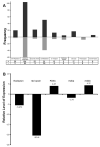Cellular expression of midkine-a and midkine-b during retinal development and photoreceptor regeneration in zebrafish
- PMID: 19263476
- PMCID: PMC3190967
- DOI: 10.1002/cne.21999
Cellular expression of midkine-a and midkine-b during retinal development and photoreceptor regeneration in zebrafish
Abstract
In the retina of adult teleosts, stem cells are sustained in two specialized niches: the ciliary marginal zone (CMZ) and the microenvironment surrounding adult Müller glia. Recently, Müller glia were identified as the regenerative stem cells in the teleost retina. Secreted signaling molecules that regulate neuronal regeneration in the retina are largely unknown. In a microarray screen to discover such factors, we identified midkine-b (mdkb). Midkine is a highly conserved heparin-binding growth factor with numerous biological functions. The zebrafish genome encodes two distinct midkine genes: mdka and mdkb. Here we describe the cellular expression of mdka and mdkb during retinal development and the initial, proliferative phase of photoreceptor regeneration. The results show that in the embryonic and larval retina mdka and mdkb are expressed in stem cells, retinal progenitors, and neurons in distinct patterns that suggest different functions for the two molecules. Following the selective death of photoreceptors in the adult, mdka and mdkb are coexpressed in horizontal cells and proliferating Müller glia and their neurogenic progeny. These data reveal that Mdka and Mdkb are signaling factors present in the retinal stem cell niches in both embryonic and mature retinas, and that their cellular expression is actively modulated during retinal development and regeneration.
Figures





Similar articles
-
The expression and function of midkine in the vertebrate retina.Br J Pharmacol. 2014 Feb;171(4):913-23. doi: 10.1111/bph.12495. Br J Pharmacol. 2014. PMID: 24460673 Free PMC article. Review.
-
Midkine-A functions upstream of Id2a to regulate cell cycle kinetics in the developing vertebrate retina.Neural Dev. 2012 Oct 30;7:33. doi: 10.1186/1749-8104-7-33. Neural Dev. 2012. PMID: 23111152 Free PMC article.
-
Midkine-a protein localization in the developing and adult retina of the zebrafish and its function during photoreceptor regeneration.PLoS One. 2015 Mar 24;10(3):e0121789. doi: 10.1371/journal.pone.0121789. eCollection 2015. PLoS One. 2015. PMID: 25803551 Free PMC article.
-
Midkine-a Is Required for Cell Cycle Progression of Müller Glia during Neuronal Regeneration in the Vertebrate Retina.J Neurosci. 2020 Feb 5;40(6):1232-1247. doi: 10.1523/JNEUROSCI.1675-19.2019. Epub 2019 Dec 27. J Neurosci. 2020. PMID: 31882403 Free PMC article.
-
Müller glia: Stem cells for generation and regeneration of retinal neurons in teleost fish.Prog Retin Eye Res. 2014 May;40:94-123. doi: 10.1016/j.preteyeres.2013.12.007. Epub 2014 Jan 8. Prog Retin Eye Res. 2014. PMID: 24412518 Free PMC article. Review.
Cited by
-
Differential expression of neuronal genes in Müller glia in two- and three-dimensional cultures.Invest Ophthalmol Vis Sci. 2011 Mar 14;52(3):1439-49. doi: 10.1167/iovs.10-6400. Print 2011 Mar. Invest Ophthalmol Vis Sci. 2011. PMID: 21051699 Free PMC article.
-
Midkine-a functions as a universal regulator of proliferation during epimorphic regeneration in adult zebrafish.PLoS One. 2020 Jun 12;15(6):e0232308. doi: 10.1371/journal.pone.0232308. eCollection 2020. PLoS One. 2020. PMID: 32530962 Free PMC article.
-
The expression and function of midkine in the vertebrate retina.Br J Pharmacol. 2014 Feb;171(4):913-23. doi: 10.1111/bph.12495. Br J Pharmacol. 2014. PMID: 24460673 Free PMC article. Review.
-
Regulation of Müller glial dependent neuronal regeneration in the damaged adult zebrafish retina.Exp Eye Res. 2014 Jun;123:131-40. doi: 10.1016/j.exer.2013.07.012. Epub 2013 Jul 20. Exp Eye Res. 2014. PMID: 23880528 Free PMC article. Review.
-
Regeneration associated transcriptional signature of retinal microglia and macrophages.Sci Rep. 2019 Mar 18;9(1):4768. doi: 10.1038/s41598-019-41298-8. Sci Rep. 2019. PMID: 30886241 Free PMC article.
References
-
- Beachy PA, Karhadkar SS, Berman DM. Tissue repair and stem cell renewal in carcinogenesis. Nature. 2004;432:324–31. - PubMed
-
- Belecky-Adams T, Tomarev S, Li HS, Ploder L, McInnes RR, Sundin O, Adler R. Pax-6, Prox 1, and Chx10 homeobox gene expression correlates with phenotypic fate of retinal precursor cells. Invest Ophthalmol Vis Sci. 1997;38:1293–303. - PubMed
-
- Bernardos RL, Raymond PA. GFAP transgenic zebrafish. Gene Expr Patterns. 2006;6:1007–13. - PubMed
Publication types
MeSH terms
Substances
Grants and funding
LinkOut - more resources
Full Text Sources
Medical
Molecular Biology Databases

